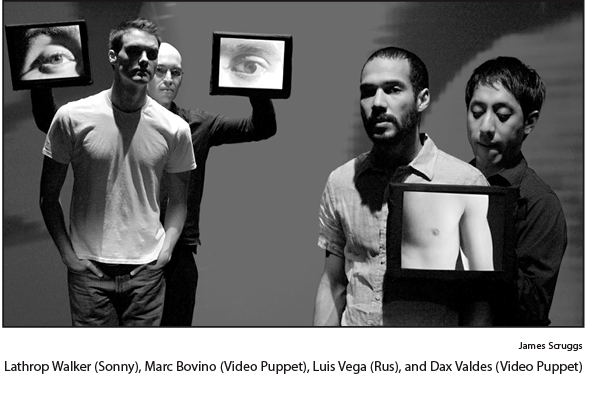By Adrienne Urbanski
(RUS)H
Through March 22
3LD Art & Technology Center
80 Greenwich St. at Rector
(212-645-0374, here.org)
In a news-saturated world where YouTube and reality television have become our way of experiencing the lives of others, it’s fitting for a theatrical work to use video to bring us closer to the characters’ interiors.
The bare stage is lit with a giant folded blue screen upon which evocative footage is displayed. The real wows of the piece come from “video puppets,” handheld screens that two puppeteers flash in front of characters, giving us glimpses into their pasts, memories and emotional states.
Rus and Sireene are a married couple lacking the spark that once burned between them; as he discusses his marriage, a video of Rus’s bare chest being buried in dirt appears next to him. While driving home from the city one, Rus accidentally runs down Sonny, a gay hustler. Rus finds himself obsessed with visiting the hospital bed where Sonny lies and praying for him to recover.
Underscoring the play are near-constant Latin dance beats, a backdrop for Rus’s tangoing, which is the clear influence of director Kristin Marting, who is known for adding choreographed form. Rus often slips out of bed with his wife—or ducks out of taxing situations—to tango across the stage.
The play’s shining scenes center on Sonny (expertly embodied by Lathrop Walker), who devotes his time to chasing pleasure—whether in the form of a one-night stand or a hit of crystal meth. The video screens display the curl of Sonny’s smoke and the glistening white powder. Flashing screens cover both the puppeteer’s inner thighs and face, showing the endless variety of bodies from which Sonny seeks out connection as he clicks away online.
When Sonny awakens from his coma, he looks at Rus adoringly, asking why he didn’t just drive away. Sonny hints that he may have stepped in front of the car in his own attempt to experience intensity. He leaps upon Rus, trying to kiss, offering up sexual gratification as a show of gratitude. Taken aback, Rus responds to the advances with violence that eventually turns sexual.
As Sireene watches her marriage deteriorate, she looks wistfully to a stack of video screens displaying her as the dance floor vixen once able to invoke passion in her husband. The video fragments of her spinning in a bright dress break off into fragments across the stage.
With mounting desperation, the characters speak to the audience directly, asking members to provide answers to their problems. Sireene locks eyes with audience members, asking for explanations for why she can’t seem to be enough for her husband. The unnerving direct address evokes discomfort in audience members wishing to remain in the anonymous darkness of a theater, but it allows for a deeper connection to the fictional lives at play.
The tension between Rus and Sonny is perhaps the one dip in an otherwise compelling script, though it is somewhat eclipsed by the smoke and mirrors of the constant video tricks. Marting stages their violent encounters as wrestling matches and tangos, a strategy that doesn’t quite seem to capture the passion Rus declares.
Overall, Marting and James Scruggs, who wrote the script and shot video footage, successfully use what could be a distracting amount of technology to add new dimensions to the characters. Still, one longs for the characters to sit down—to embrace one another—for there to be something more in their lives than the flashes of images against the austere blue screen. When in bed, the couple stands in front of a video projection of a bed, making even their slumber seem sad and artificial.
This may have been what Scruggs had in mind: displaying the coldness of a life cut off from reality through video, television, and the Internet, where feeling anything real is a rare occurrence.



































